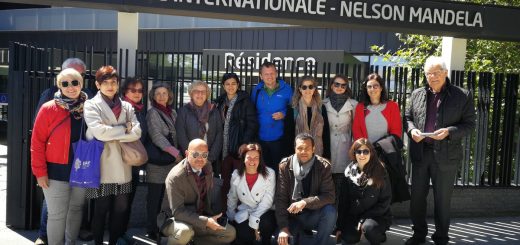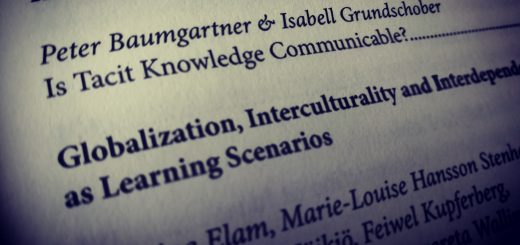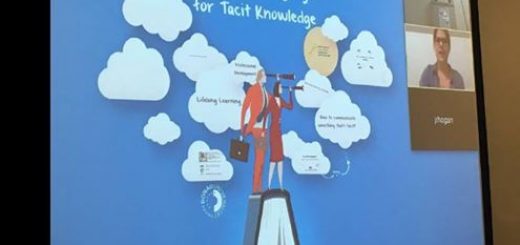Sharing tacit knowledge
As I am writing at the moment my paper for PUARL, I am reading a lot about tacit knowledge. I have already read Polanyi (“The Tacit Dimension” and parts of “Personal Knowledge”) but I am looking for more practical aproaches – Polanyi is quite vague sometimes and philosophical. I truly appreciate that, but I want to find ways to facilitate the communication of tacit knowledge.
What is informal learning? Intentional or unintentional?
I use the common definiton for informal learning according to Cedefop:
“Learning resulting from daily activities related to work, family or leisure. It is not organised or structured in terms of objectives, time or learning support. Informal learning is in most cases unintentional from the learner’s perspective.
Comments:
- Informal learning outcomes may be validated and certified;
- Informal learning is also referred to as experiential or incidental/random learning.
Source: Cedefop, 2008.”
So as it seems – it’s about unintentional learning. But one could argue about that. What about reading a book about some topic? That’s not unintentional. I WANT to learning something about a special topic. Or I want to learn a programming language. I think about how to do it, eg. online courses, reading online, trying it out etc. – that’s planned and structured. It has a clear aim. Where to draw the line?
I think a differentiation between types of certification would be easier: Formal learning is everything that is awarded with ECTS and which is easily incorporated within a study/learning programme leading to and offical award. Non-formal is certified learning which is not (yet) connected to ECTS. Informal learning is all other learning, not certified in any way.
This differentiation between informal, non-formal and formal learning seems necessary for policy and for talking about learning in general. But it is not really clear, where to put tacit knowing here. Actually, it is part of all learning activties. “All knowledge is either tacit or rooted in tacit knowledge.” (Sveiby 1997)
Tacit knowing: Good questions to ask yourself to get a bit deeper into the matter…
Michael Eraut (2000) also had some good ideas about tacit knowing and he asked important questions:
- Does tacit knowledge refer to knowledge which is not communicated, or knowledge which cannot be communicated?
- Is it an attribute of the knower which some can communicate and some cannot; or is it an attribute of the knowledge itself?
- Could it be an element of both?
To no. 1: I think tacit knowing cannot be communicated, like Polanyi stated it, once it is explicitly looked at, its meaning is a different one. But we can approach tacit knowing. Or its already enough to take a look at something, what is usually tacit. Tacit knowing is part of formal, informal and non-formal learning. Always if we say something explicitly, we rely on other things, which were explicitly learnt one day, but in the situation, as one is concentrating on a certain action of thing, it stays tacit. Tacit knowing is facilitating the action. It is embodied, we truly know it and use it as a tool. Once we look at the tool explicitly it cannot work as a tool in this situation anymore. Eg. I try to hit a nail with a hammer. I already know how the hammer feels in my hand and how to use it. So I concentrate on the nail, which I want to hit. In this situation the hammer acts like a part of the body and I “feel” how the tip of the hammer is hitting the nail, not how the hammer feels in my hand. If I would concentrate on the hammer in my hand, I probably would miss the nail and rather hit my finger.
The same thing with language. I know how my mouth and my tongue forms syllables. I don’t have to exercise it, I’ve learned it long time ago as a baby. I can talk full sentences without wasting a single thought on how to do it. If I know started to say one word over and over again, starting to focus on how my mouth forms the syllables, the word suddenly doesn’t have any meaning anymore to me, the word even sounds alienating, somehow strange. So we rely on tacit knowing of certain things, we are able to do something, without knowing it in the second we do something else that we need all those other skills and competences for being able to do this one certain action. But we can, at least partly, think about what makes us able to do certain actions. Of course, it wouldn’t be complete. And what we only can do is to write rules and give advice how we do it and what kind of skills we need and how we incorporate them when doing a specific action. But it is just rules. Every person or system has to find his/her/its own way of doing it. Everyone is different, maybe also relying on different tacit knowing but still successful on doing the same tasks. But there might be some kind of lowest common denominator.
And I think this can be best done through discovering patterns and forming a pattern language. A pattern has a simple structure: Problem, Context, Solution, Forces.
It is just containing essential elements, never narrowing the way how to do it and still enabling people to do it. People find different solutions, its never the same. I think this might be because of their personal knowledge.
I need to do further research in the topic in every case.
The SECI-Model
I find the SECI-Model by Nonaka & Takeuchi very interesting, as it is focused on how knowledge can be shared:
Nonaka&Takeuchi refer to Polanyi when using the wording “tacit knowledge”, so this is a good point for me to go further in the matter of tacit knowledge, as I started my research achtivities with Polanyi in autumn 2015. The SECI-Model became popular and is widely known and used. Nonaka&Takeuchi understand explicit knowledge as knowledge which can be easily put into words or numbers. Tacit knowledge isn’t so easy to communicate for them, similar like Polanyi understood it. Tacit knowing is deeply achored in the activities and tasks we are performing. The skill unfolds within the action. Knowledge is embedded in action and in the end it is only accessible to a learner through action. Rules are helpful, but they don’t replace the learning process.
All in all, Nonaka&Takeuchi’s aproach seems more pracitcable and like the next step after Polanyi. At least it is important to consider it in futher research.
Links with further information:
http://www.sveiby.com/articles/Polanyi.html
German:
https://www.econstor.eu/dspace/bitstream/10419/36700/1/Wissensmanagement%20Reloaded_Dada%20Lin.pdf




1 Response
[…] especially in presence, the implemented didactic design is often based on intuition and tacit knowledge of the teachers. This often works well face-to-face, but when learning and teaching online, one can […]